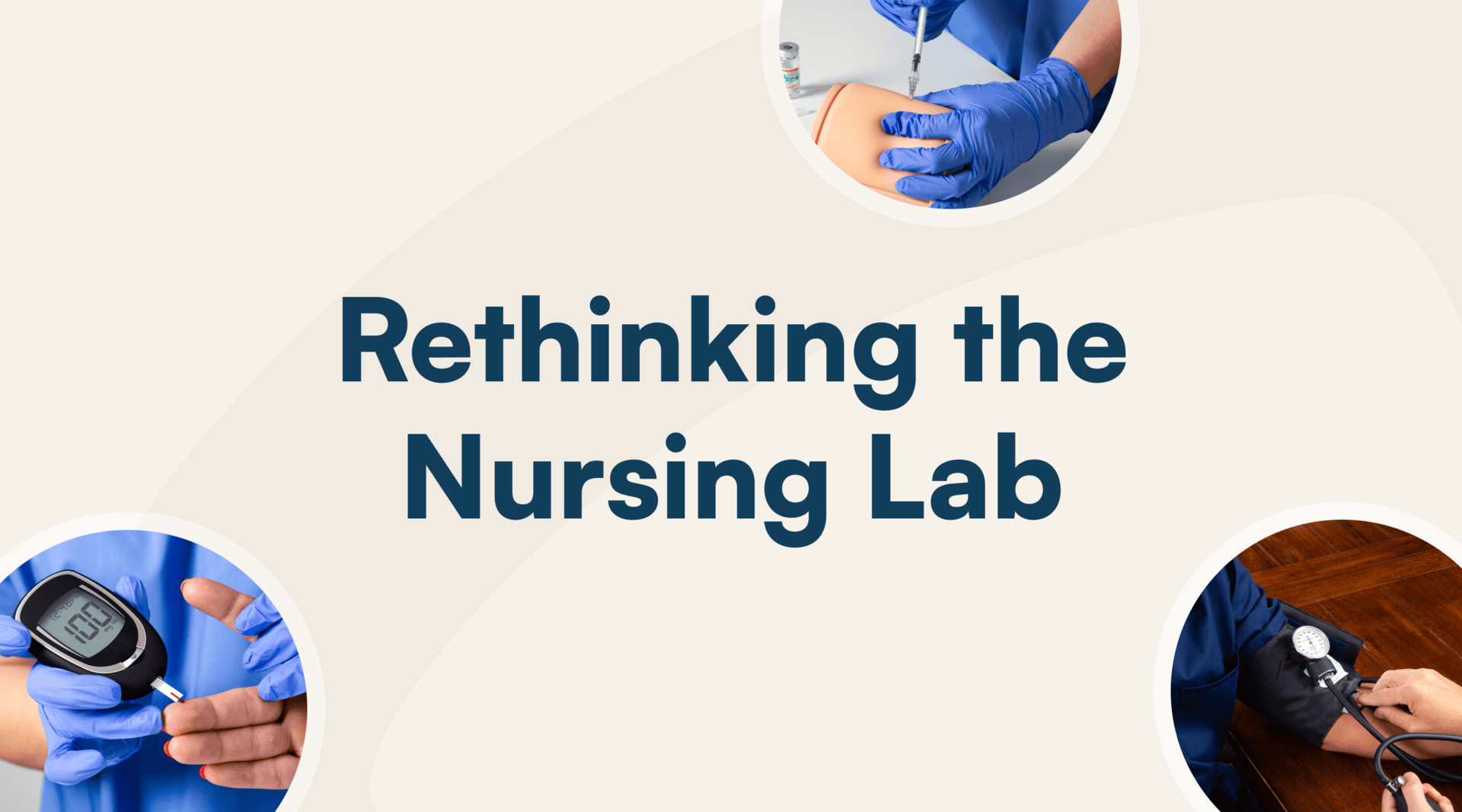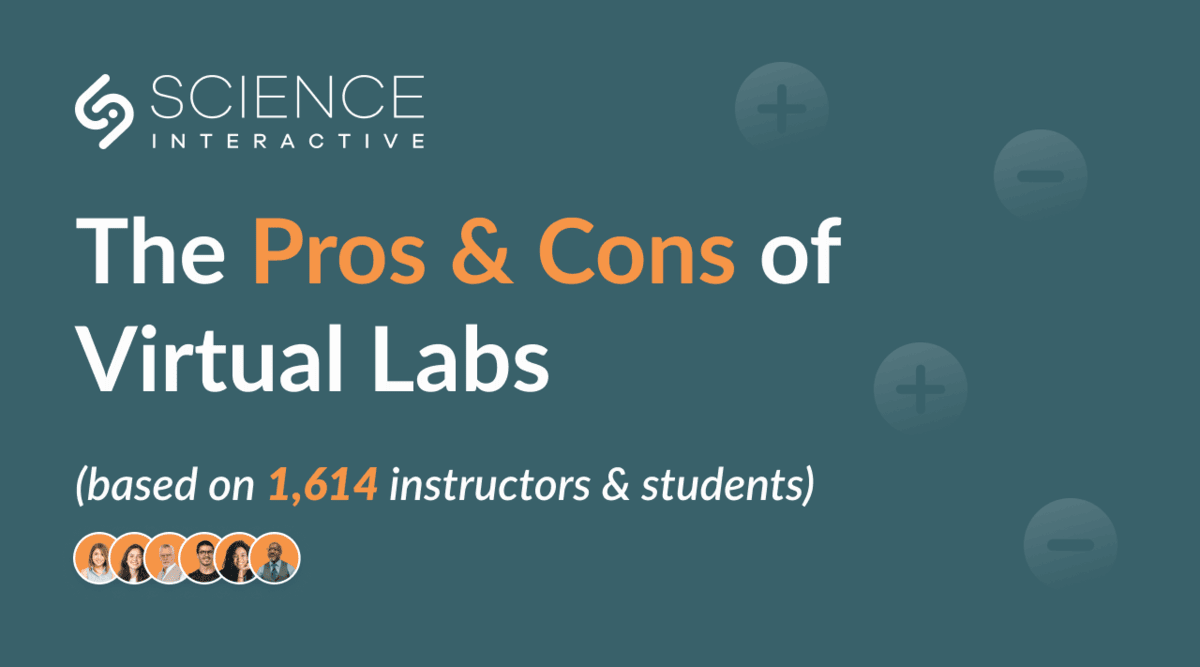“Science is hard! I do better to learn at my own pace and re-read things that I didn’t understand before going to the next topic, whereas in class with lecture, the professor moves at a very fast pace.”
That’s just what one student said in our survey of over 1,293 students who took online science labs in 2022-23. That sentiment echoes through many of the student responses, and underscores the importance of delivering online lab courses in ways that support students’ needs and help them engage more deeply with course material. To do that well, lab format, specifically hands-on and virtual labs (a.k.a online science lab simulations), plays a powerful role—and the 321 instructors we surveyed on the topic said the same.
In this article, we explore some of the reasons why virtual labs have gained popularity, and share insights from our Annual Lab Report that shed light on how to use virtual labs most effectively and when they fall short.
The Drawbacks of Virtual Science Labs
While it’s clear virtual labs have an important role in your course, there are also drawbacks—especially if you’re relying solely on this format for labs. Studies have shown that courses using virtual-only simulations end up being less effective in providing students with the experiences they need to acquire new skills, achieve course competencies, and apply knowledge.
Lacking Real-World Application: Virtual labs can bridge theory and practice by providing a multimedia connection between abstract concepts and practical execution. But when you think about how to teach organic chemistry online, for example, consider the years of training it takes to become skilled in research laboratory techniques. Dealing with the frustrations of getting equipment to work and developing the muscle memory of performing work hands-on cannot be replicated in the virtual platforms. For students looking to pursue advanced courses or even secure jobs in any science-related field, real-world experience is an essential part of the process for becoming skilled.
According to our recent research report, 74% of students who only participated in virtual labs said they would have felt more confident applying what they learned in real-world situations if their labs had a hands-on component. In fact, this student shared the impact of those opportunities.

Less Effective Student Learning: When used as the only form of learning, virtual labs don’t provide a holistic and compelling learning experience. The experience of working with physical solutions and lab equipment are considered part of the learning process, and a student who wants to be a chemist, for instance, must handle chemicals in a physical lab at some point. So despite their increasing levels of realism and fidelity to the physical world, virtual labs aren’t comparable to the experience of conducting physical labs, which has important implications when it comes to student performance and achievement.
Prone to Cheating: Another drawback of virtual labs is the ease in which students might be tempted to cheat. With virtual labs, it’s easy to click through simulations quickly and find answers online. As Biology instructor at Richmond Community College Lori Frear explains, “With simulated labs, students will appear to do better — meaning, they get higher grades than those doing hands-on online labs. That’s because digital labs are often based on effort, whereas with hands-on labs, if students don’t show evidence of having completed the lab, it will impact their grade. You can’t wing it in hands-on online labs and expect to learn it and get a good grade. The hands-on labs allow students to process information and think through concepts in ways that the clicking of digital-only labs don’t allow.”
Using hands-on labs mimics a traditional lab setting, making it more difficult to cheat. So just be sure that if you’re using virtual labs, you’re also using technology that can curb academic misconduct. For example, lab management platforms should have built-in tools that prevent students from accessing content during evaluations.
Accessibility Concerns: Because virtual science labs rely on a variety of technologies, accessibility is particularly important. Before selecting a virtual lab, ensure that all students will be able to use the program easily. Some factors to consider include:
- Do all videos and audio have captions and transcripts?
- Will a screen reader correctly read all aspects of the program?
- Can the entire program be navigated with just a keyboard?
- Will the program work with low-quality or unreliable internet access?
- Can the lab be completed on a phone or tablet?
In general, virtual science labs can be an important element in program’s efforts to
expand access to lab-based courses but are often not a good substitute for sophisticated, highly complex lab activities, which brings us to a more effective approach.
The Benefits of Virtual Labs
Virtual science labs are digital presentations that provide students with a way to experience the experimental steps of a scientific experiment on a screen. They use graphics and animations to present specific topics. Some are like videos — students simply click play and watch the simulation take place — whereas others are interactive, allowing students to manipulate variables to discover different outcomes. Some examples include representations that demonstrate a law of physics, the effects of gravity, or a frog dissection typical of many biology lab simulations.
There are several benefits to using virtual simulations in your online lab course. As one student puts it: “The online labs gave us a chance to do experiments over and over again, until they were clearly understood. That was a great advantage.”
In fact, 81% of students said these online labs made their course more engaging. In addition to repeating these labs in a low-stakes environment, as many times as needed, to master content, students could interact more thoughtfully with course material, complete labs at their own pace, and get immediate feedback tailored to their performance. And there are several instances where it makes sense to choose virtual labs.
Observing the Unobservable: An important benefit of virtual labs is that students can ‘conduct’ experiments on phenomena that would normally be unobservable or unsafe to observe (de Jong et al., 2013; Faulconer & Gruss, 2018). Virtual labs can portray abstract objects, such as light rays, that students cannot see in a physical lab, which helps students understand the concept better.
Some chemical reactions might also be unsafe to conduct in-person but could be easily reproduced using a chemistry lab simulator. For example, take experiments in qualitative analysis that use toxic metals or the nitrogen dioxide/dinitrogen tetroxide dynamic equilibrium. These require too toxic of chemicals and too expensive of glassware to be able to provide students with a hands-on experience, but virtually through a simulation, students can conduct tests and see the reactions in the context of a real-world scenario. Virtual labs, like these, have been shown to increase students’ conceptual understanding of certain topics (Kollöffel & de Jong, 2013).
Particular Learning Outcomes: Virtual labs can often be appropriate to adopt for certain learning outcomes and topics. For example, learning about the scientific method or graphing preparation don’t require a hands-on lab and are topics best approached using a virtual lab.
Price Consciousness: With virtual labs, students don’t have to pay for access to large scientific apparatus or expensive equipment, like they would for on-campus labs. In fact, some lab equipment is so expensive, it’s not even feasible to have them on campus. Incorporating a mix of virtual with hands-on labs can then be an effective strategy for balancing costs.
Safety: In a virtual lab, students can’t injure themselves or others, or break equipment, like they could in a campus lab or hands-on home setting. Still, the best virtual labs should instruct students on lab safety protocols and show them how to use equipment and materials properly—setting them up for safety and success should they ever find themselves in a more traditional lab setting.
Repeatability & Preparation: Finally, with a virtual lab, a student can run a digital experiment as many times as needed to get the desired result. With each experiment, students can manipulate variables, run the experiment, and immediately see the results. With each run, students engage more deeply with the concept, which is helpful for struggling students or those who need to repeat activities for a deeper understanding. Similarly, using virtual pre-labs in preparation for on- campus labs can also be beneficial, allowing students to practice repeatedly before entering a physical lab.
The Right Mix of Hands-on & Virtual Labs
We already know what you’re probably thinking! Hands-on labs increase cost. They’re hard to implement. And does anyone know just how effective they are?
Hands-on Improves Student Learning
Well, it turns out adopting hands-on labs is easier than you think and significantly improves learning outcomes. 85% of instructors using hands-on labs were confident students could apply what they learned to the real world. Unlike virtual simulations, students gain the hands-on experience of using equipment and carrying out experiments — building technical and psychomotor skills as well as expanding students’ abilities to develop the problem-solving and critical thinking skills students would in a traditional lab.
Hands-on Replicate the In-Person Lab Experience
Comparative studies suggest that students learn just as much from these labs and in ways similar to those who attend in-person labs, while virtual simulations when used alone aren’t as effective (Casanova et al., 2006; Reuter, 2009). In fact, 71% of surveyed instructors said using hands-on labs made their labs feel comparable to an in-person experience, whereas the majority of instructors using virtual simulations said the lab format was NOT comparable to an in-person lab experience.
Hands-on Costs, Implementation & Safety Concerns Eased
Further, when it comes to cost, survey data showed that 22% of instructors cite cost as the reason they didn’t adopt hands-on labs. However, those instructors who did use hands-on labs thought the cost was commensurate with the value of the experience. In fact, both instructors and students agree that students learn more when they have the opportunity to do hands-on labs at home AND the cost of doing those hands-on labs is worth the value received. Nearly ¾ of students said the cost of the hands-on labs was aligned with the value received.
In fact, Donna Uguccioni, Anatomy & Physiology Professor at Cape Fear Community College, says, “When I started teaching Anatomy & Physiology online, we used kits but the costs became prohibitive for the students and the goals of the college. After that, we used a hard copy lab manual, which matched what we use in hybrid and seated classes. It worked fine but not the best option for a fully online course. Then we found Science Interactive. The labs tie into what we cover in class and offer students a hands-on lab experience in their own home. The kit is completely customizable to match our learning objectives, and the price point makes it a perfect addition and replacement.”
Similarly, nearly a third of instructors say they don’t use hands-on labs because of implementation concerns. While implementing hands-on might seem daunting at first glance, it can be a smooth process when you find partners experienced in supporting instructors through implementation and that can provide ready-made lab kits to meet your needs.
Finally, hands-on labs can be designed to ensure student safety. With a focus on training, workstation preparation, clear guidance, instruction on how to handle lab equipment, and the use of microscaling, hands-on labs can be done safely at home without compromising quality.
The Most Effective Approach to Online Labs
“For someone like me who is a bit older, it may have benefitted me to have had a mixture of hands-on as well as virtual. I say that because I had so much fear of failure and that I wasn’t doing the experiments right.”
This student, along with others, emphasize the importance of using a blend of hands-on and virtual labs, as well as the benefits of using virtual simulations to supplement in-person courses:

In the end, the most successful courses will use an intentional blend of both virtual and hands-on science labs to create the most effective and authentic student learning experience possible.
Identifying lessons that can be done virtually and others that can provide hands-on experience will keep course costs reasonable, ensure student safety and content accessibility, and prepare students with the skills and knowledge needed to apply concepts to the real world.
If you’re interested in delivering a more authentic and engaging online lab course, we can help.
TLDR; Infographic
Click here to download and save the infographic.
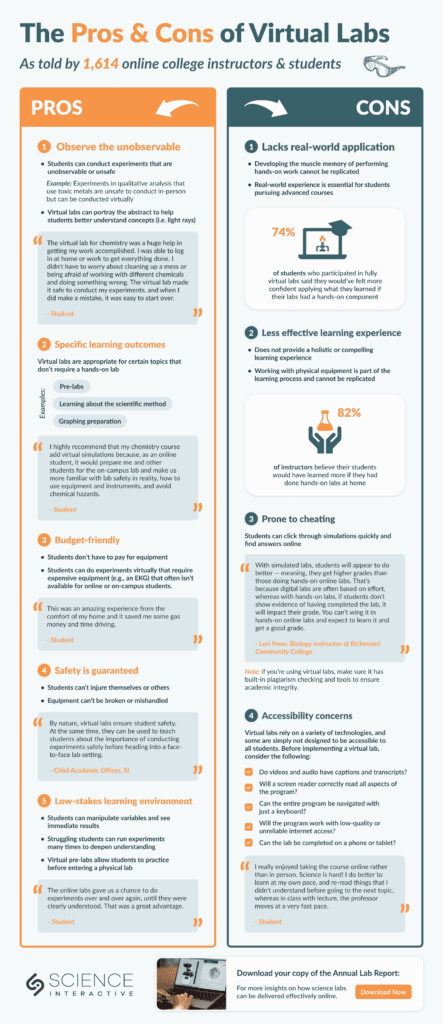
Discover more articles
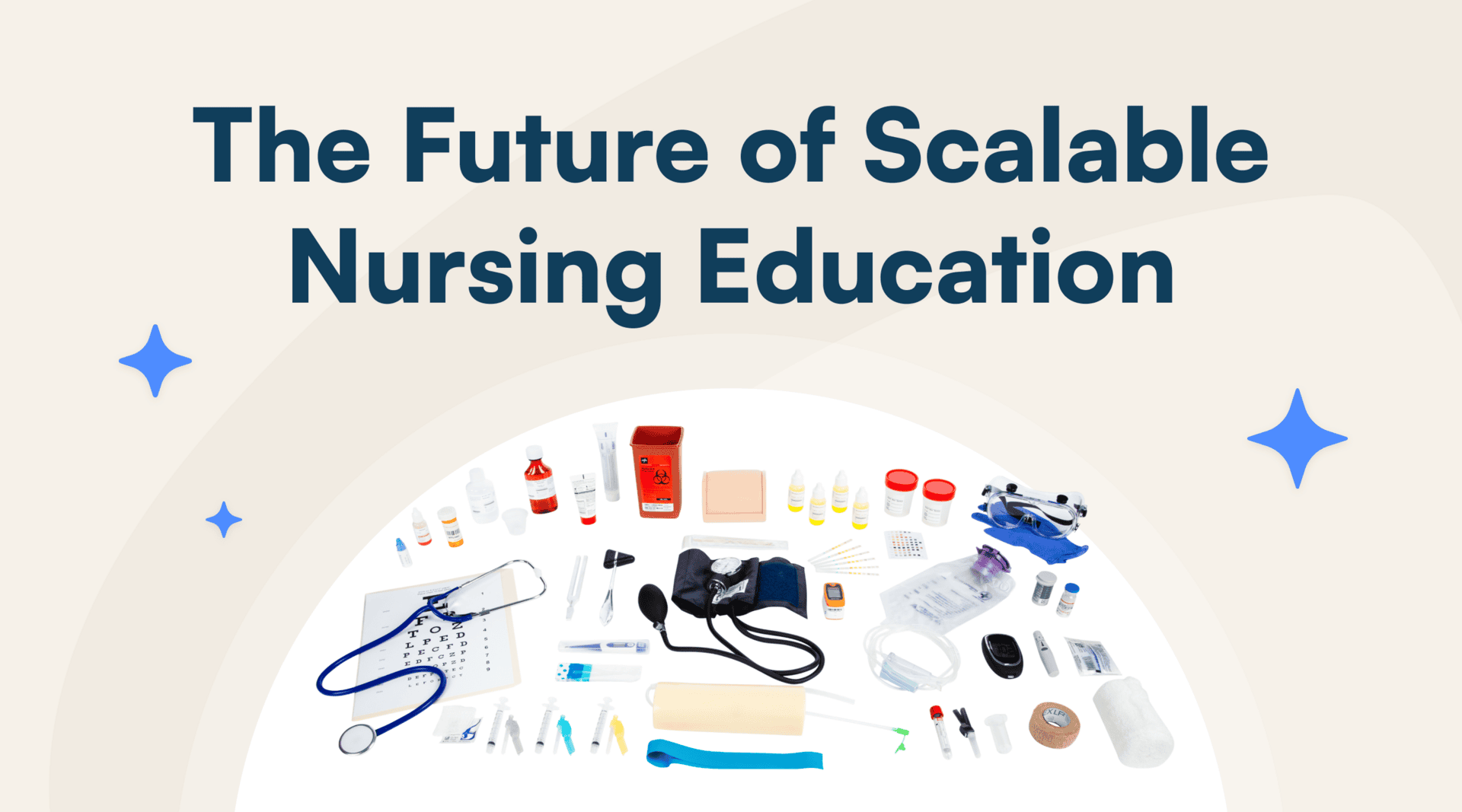
Science Interactive Launches New Nursing Fundamentals
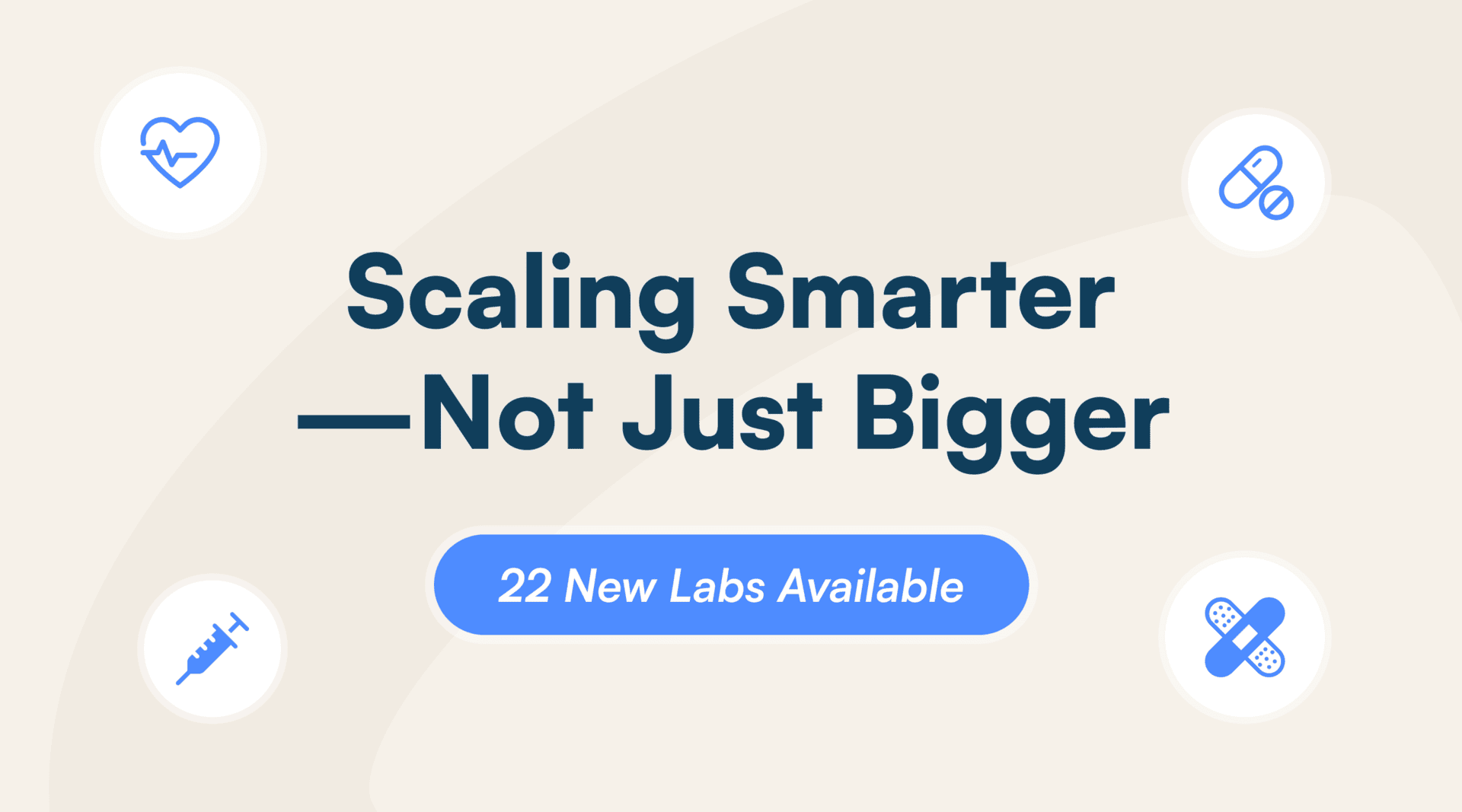
What Clinical-Ready Actually Looks Like (And How to Get There Sooner)
